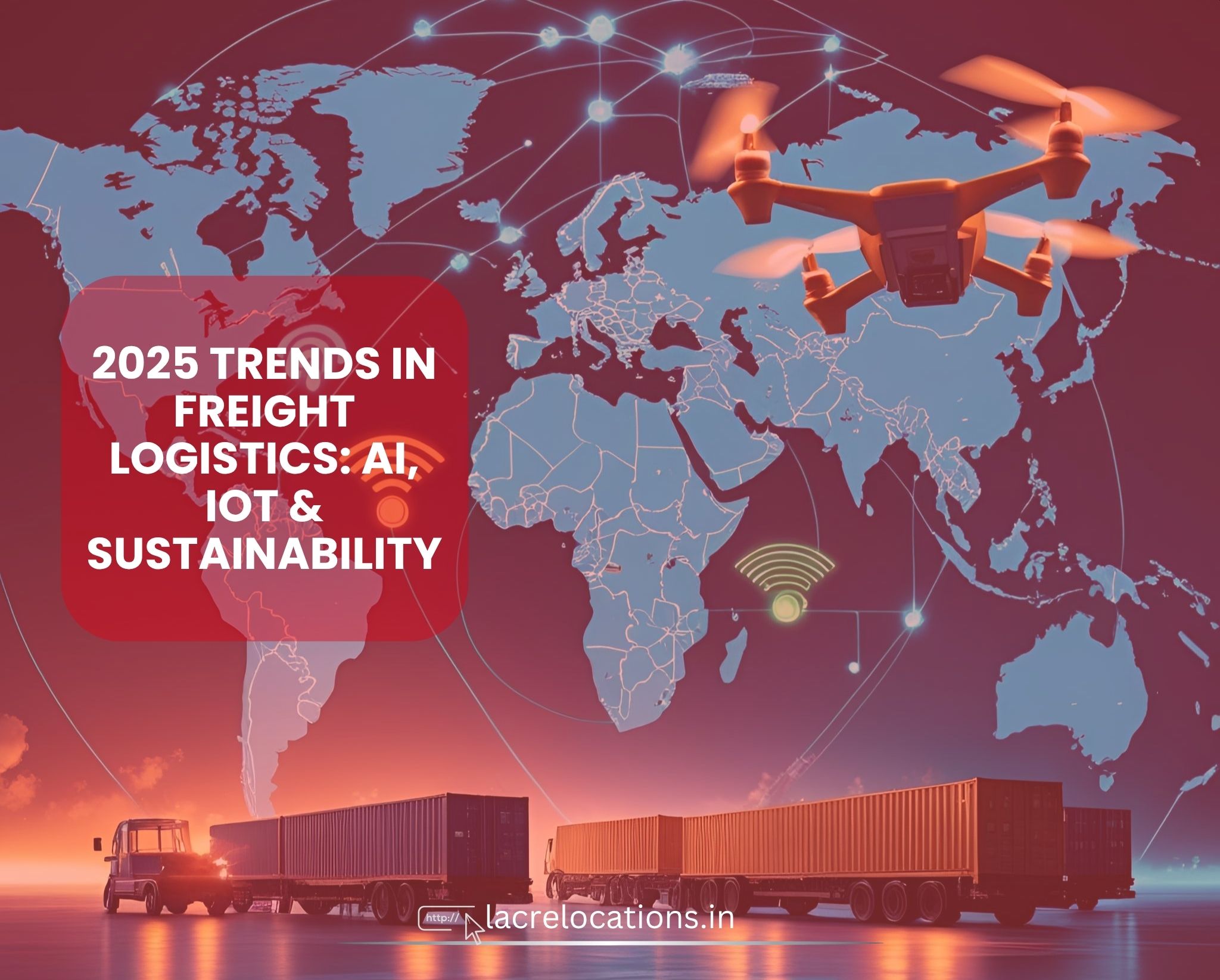In 2025 freight logistics will enter a revolutionary phase where accountability and intelligence coexist. Logistics is changing from manual to intelligent from carbon heavy to climate responsible, as demand for quicker, more transparent and ecologically friendly supply chains increase.
In order to stay ahead of the competition businesses are investing in AI, IoT and sustainable logistic techniques as evidenced by the freight logistics trends of 2025. Smart decisions, predictive capabilities and minimizing environmental impact are more important in this new era of freight management than speed alone.
Let’s examine how these developments are influencing international freight Forwarders in the future.
Trend #1 – AI in Freight: Data-Driven, Predictive, Smart
The increasing use of AI in freight logistics is making it smart, fast and more predictive in 2025. The majority of traditional logistics models relied on manual coordination and historical pattern make them reactive. Operations are now moving toward a proactive, data driven future because of artificial intelligence.
Through real time analysis of massive amounts of data, AI is turning freight into a more automated and intelligent system. Decisions about logistics can now be made instantly from dispatch to delivery which decreases human error, boosts productivity and unlocks substantial cost saving.
- Route optimization: AI algorithms examine both historical and current data, such as traffic, weather, road closures, and customer delivery windows, to identify the most efficient routes. In complex delivery scenarios, AI can also prioritize and sequence stops to cut down on mileage and fuel consumption.
- Fleet scheduling: AI system use capacity, availability, legal compliance and traffic data to manage vehicle assignment and schedule. This guarantees optimal usage and decreases idle time.
- Automated dispatch: Based on proximity, driver availability and real time shipment priorities freight is dynamically assigned. This guarantees fast reaction time and more intelligent resource allocation.
- Demand forecasting: To assist logistics team in allocating resources ahead of time, machine learning examines past shipping volume and seasonal pattern.
- Load optimisation: AI efficiently loads goods into trucks or containers to maximize space utilisation and minimise travel time.
Businesses are experiencing quantifiable advantages by putting intelligent logistics operations into place:
- Lower expenses as a result of improved resource planning and fuel efficiency
- Saving time through automated, instantaneous decision making
- Increased precision in route planning and delivery schedules
- Reduced emissions that support more general sustainability objectives
AI provides long-term strategic value, resilience and agility in a hyperconnected and uncertain logistics environment. It serves as a basis for more intelligent international freight, not just an efficiency tool.
Trend #2 – IoT for Real-Time Visibility and Operational Control
As logistics networks become more complex and customer expectations continue to rise, visibility is no longer optional—it’s essential. In 2025 IoT in freight is important in providing that visibility. Logistics companies‘ methods for tracking, monitoring and managing moving assets are being revolutionized by the Internet of Things.
A new degree of control and transparency is being made possible by IoT devices that are integrated into cars, containers, and even individual packages. Continuous data transmission from these intelligent sensors provides logistics platforms with insightful information that facilitates fast and better decision making.
How IoT is changing the game:
- Tracking freight in real time: Live shipment location updates are provided by GPS and Bluetooth enabled sensors giving customers and logistics team complete visibility.
- Environmental monitoring: IoT sensors track movement, temperature and humidity which is essential for sensitive cargo like electronics, perishables and medications. This reduces spoiling and guarantees regulatory compliance.
- Security and tampering alerts: Smart devices are able to identify unexpected stops, door openings, or unwanted access, and they can promptly sound an alarm to stop contamination or theft.
- Predictive maintenance: Teams can reduce downtime and increase fleet availability by using IoT data from vehicle sensors to predict mechanical problems or breakdowns before they happen.
- Connected logistics ecosystems: IoT devices easily interface with telematics, ERP and WMS systems to provide a centralized platform where all parties involved can view and control freight in real time.
Logistics companies can react to disruptions more quickly, reroute shipments more cleverly and keep strict control over delivery schedule because of this connectivity. Businesses can enhance customer service, decrease operational risk and maximize overall performance by having the ability to monitor locations and conditions.
Trend #3 – Sustainable Freight: Logistics with a Lighter Footprint
Global logistics has made sustainability a strategic necessity and in 2025 the sector faces greater pressure than ever to lessen its environmental effect without sacrificing operational effectiveness. Businesses are using sustainable logistics techniques to future proof their operations as regulations tighten and consumers favour eco friendly partners.
The once high emission industry of freight transportation is going green. Logistics companies are adopting solutions that promote both environmental objectives and business continuity such as smart routing systems and electrified fleets.
In 2025, top environmentally friendly logistics options include:
- Hybrid and electric cars: Electric trucks and vans are becoming more and more popular especially for last-minute delivery. These cars save fuel and maintenance expense while reducing emissions.
- Alternative fuels: With cleaner combustion options biodiesel, LNG and hydrogen powered engine are increasingly being used in long haul and maritime freight.
- AI-powered route optimization: By minimizing needless miles fuel use and idle time route planning tools help lower expense and emission.
- Intelligent load planning: Using cargo space and packaging effectively decreases the number of trip and waste produced.
- Green packaging and reverse logistics: A circular logistic model is supported by reducing material consumption and creating effective return procedures.
- Dashboards for tracking emissions: To track, report and enhance their carbon performance across lanes and modes a number of logistics companies are utilizing digital tools.
Beyond its effects on the environment, eco friendly logistics solutions have the following advantages:
- Reduced fuel expenses: Operation that use less energy result in noticeable financial savings.
- Adherence to regulations: Businesses stay ahead of emission regulation by proactively implementing cleaner practices.
- Increased brand equity: Customers, investors and business partners are moved by sustainability pledges.
- Operational resilience: Over time, effective, low impact freight operations are frequently more flexible and economical.
In the end business that adopt sustainable freight today are setting themselves up to be leaders in a logistics future that prioritizes creativity, responsibility and long-term effects.
Trend #4 – Automation & Smart Warehousing
In 2025 the logistics sector is quickly moving toward tech-powered, intelligent operations and the warehouse is one location where this is most used. Businesses are investing in freight automation 2025 to update inventory handling and fulfillment procedures because of the need for speed, accuracy and efficiency.
The use of technology to control the movement, processing and storage of goods with little to no human involvement is known as warehouse automation. This covers software driven inventory controls, robotics, automated picking systems, and intelligent conveyors. When combined, these technologies are transforming the warehouse into a highly responsive, data-rich space.
Examples of innovations are:
- AMRs or autonomous mobile robots: These pick and move item across warehouse floor while collaborating safely with human employees to boost productivity.
- Barcode scanning and RFID: Automated identification and data capture (AIDC) technology save time and increases accuracy by replacing manual inventory checks.
- AI driven inventory: To maintain optimal stock levels, machine learning algorithms examine supply chain data, sales trend and seasonal patterns.
- Labor planning and predictive analytic: Demand forecasting facilitate more effective resource allocation and more consistent customer satisfaction.
- Real-time data access: Cloud based platform make it possible to view order statuses and inventory levels instantly, both within the warehouse and throughout the supply chain.
- ERP integration: Smart warehousing tool syncs seamlessly with enterprise system to break down silos and create a unified logistics strategy.
These innovation support the creation of a smart supply chain one that is agile, scalable and able to respond quickly to fluctuation in demand. By reducing manual errors, accelerating order processing and improving data accuracy, smart warehouses help businesses fulfil orders faster while lowering operational costs.
In an increasingly competitive logistics landscape, the companies embracing automation are not just improving efficiency they’re building the foundation for sustainable, customer centric growth.
Trend #5 – Predictive Planning for Risk-Free Freight
Proactive planning is now required rather than a competitive advantage as global supply chains experience greater levels of disruption from weather, political unrest and market volatility. Logistics executives are depending on predictive freight management in 2025 to foresee hazards and confidently optimize freight movement.
Predictive analytics enables logistics teams to shift from reactive to proactive approaches by examining a mix of historical trends and operational data collected in real time. A supply chain that is more reliable, robust and effective.
Teams are empowered by predictive freight management to:
- Use trends in demand: To improve inventory planning, machine learning models detect regional trends, seasonal surges, and consumer behavior.
- Place inventory as efficiently as possible: By placing products closer to their intended location, shipping times and storage expense is decreased.
- Increase capacity utilization: By using predictive tools, trailer or container loads can be planned more effectively, preventing underuse or expensive overflow shipments.
- Handle disruptions proactively: Businesses can reroute freight, find alternative suppliers or change modes before a delay worsen by keeping an eye on real time data and external risk factors.
- Boost client satisfaction: Better product availability and precise delivery windows result in higher service standard and increased trust.
Businesses can use the possible effects of a variety of risks, such as supply bottlenecks and increases in fuel prices, and simulate various logistics scenarios with advanced supply chain forecasting. This forward thinking understanding makes it possible to allocate infrastructure, labour and transportation more effectively which results in significant cost savings and improved operational resilience.
Trend #6 – Flexible, Resilient Supply Chains
Being able to quickly adjust has become a crucial competitive advantage in logistics in an era characterized by unpredictability. The development of supply chain that are not only quick and effective but also adaptable and durable is important to the future of freight logistics. The top freight companies in 2025 will be those that make investment in systems that work well under pressure without breaking.
Modern supply chain is constantly threatened by everything from shifting fuel prices and geopolitical unpredictability to labor shortages and climate-related disruptions. A change in structure toward localized tactics, redundancy and agility.
Important techniques:
- Regional warehousing and nearshoring: Businesses can lessen their reliance on long haul routes and global bottleneck by putting inventory closer to their final consumers. This adds a layer of geographic flexibility and cut down on delivery time.
- Dynamic route rerouting: Using AI and IoT data, real-time rerouting enables freight to avoid closed borders, blocked roads, or bad weather, ensuring shipment to arrive on time.
- Options for multimodal transportation: When one mode of transportation fails, continuity is guaranteed when sea, air, rail and road alternatives are all incorporated into a single logistics plan.
- Building a diverse supplier network: By working with multiple suppliers across different locations, you can reduce the impact of regional disruptions and enhance the stability of your procurement process.
- Scenario planning and simulation: The logistics team can use digital twins and predictive modeling to test their responses to potential crises, which helps improve their readiness before any issues arise.
In addition to reducing risk the move to resilient supply chains aims to increase operational agility and spur growth in unpredictable times. Businesses that embrace flexibility can scale more confidently, serve customers more consistently, and react to market changes more quickly.
Key Challenges: Technology Adoption Isn’t Always Smooth
While it’s clear that digital transformation in freight logistics brings a lot of advantages, the journey to modernization can be a little different. Many companies hit some bumps along the way, facing challenges like budget limitations and pushback from their teams. As cutting edge technologies such as AI, IoT and automation become the norm ensuring they integrate smooth and is just as crucial as the tech itself. Even the most innovative logistics providers can run into hurdles when rolling out new systems:
- High integration costs: Setting up smart logistics platforms, robotics or IoT infrastructure often demands an initial investment in hardware, software, and IT frameworks.
- Training and skills gaps: Employees might lack the technical know-how to effectively operate or maintain these new systems, which can slow down adoption and impact return on investment.
- Change resistance: Cultural resistance within teams can slow progress, particularly in companies used to manual workflows or legacy systems.
These freight digitalization challenges underscore the need for a strategic, phased approach to adoption. Businesses that succeed typically:
- Start with pilot programs before scaling across regions or operations
- Invest in staff enablement, offering continuous training and upskilling opportunities
- Engage cross-functional digital teams that bring together IT, operations, and leadership to manage change collaboratively
- Work with expert partners to guide implementation and ensure alignment with business goals
By addressing both the technical and human sides of transformation, companies can avoid common pitfalls and accelerate their path toward a digitally mature logistics operation.
Conclusion: Building a Smarter, Greener Freight Future
The freight industry in 2025 is no longer defined by outdated procedures and rigid supply chains. Instead, it’s being transformed by a wave of innovation driven by AI, IoT and sustainable logistics practices. These pivotal changes will determine which companies thrive and which ones fall behind. The logistics leaders of the future are those who prioritize smart, adaptable, and eco-friendly strategies today—embracing everything from green logistics solutions and freight automation to real-time tracking and predictive management. The message for businesses navigating the future of freight logistics is crystal clear: intelligence, sustainability, and flexibility are essential for long-term success and resilience. At LAC Relocations, our mission is to provide cutting-edge, eco-friendly freight solutions that meet the needs of tomorrow’s global corporations.

















